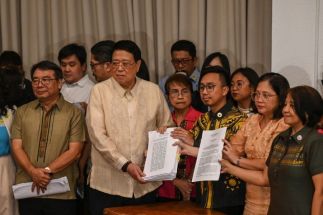If Singapore and Hong Kong can do it, why can't we?

In the past two weeks we have been preoccupied in analyzing the problem we experienced in the flooding caused by typhoons “Ondoy” and “Pepeng”. It is evident that many of us are frustrated at the city and national officials who have neglected their work. They have focused more on projects that do not meet the basic infrastructure needs of the people or what is good for the country.
We want to believe that this nightmare will never happen again. But in reality, it may strike back especially if we do not do anything about it. If our officials do not resolve the bigger problems and choose to look at the minute issues then disaster is surely on its way. The earth is naturally undergoing a transformation and if we compound its movement with man-made mistakes and irresponsible acts, the condition will worsen. It is time for us to know our priorities. The government can start by spending (perhaps with the pork barrel funds?) on the development of good infrastructure, building floodways, relocating squatters to emergency housing tenements and work on more efficient disaster management programs.
Singapore is situated 137 km north of the equator and is subject to heavy tropical rainstorms between the months of November and January. Flooding in Singapore was prevalent in the past as the older parts of the city were built relatively on low-lying areas. The drainage systems were not adequate to convey storm water runoff effectively. Rapid urbanization in the 1970’s and 1980’s brought about drastic transformations of the hydrological characteristics of the drainage catchments in the country. The Singapore government adopted strategies to keep the flood situation under control despite the vast extent of new land developments that are continuously taking place. Drainage control policies pursued by the Drainage Department were implemented over the years for flood alleviation and prevention.
In 2008, after decades of planning and hard work, the Marina Barrage was completed. It is an important milestone in the Singapore water story. This barrage creates Singapore’s 15th reservoir and the first in the heart of the city. It collects rainwater from the largest catchment in Singapore, about one-sixth of the land area, in the most densely built-up part of the island. It also alleviates flooding in the low-lying areas in the city such as Chinatown, Boat Quay, Jalan Besar and Geylang. During heavy rains, the series of nine crest gates at the dam are activated to release excess storm water into the sea when the tide is low. During high tide, the giant pumps which are capable of pumping an Olympic-size swimming pool per minute, drain excess storm water into the sea. In addition, the barrage ensures a constant water level and calm waters all year round, making the Marina reservoir a beautiful and convenient venue for recreation activities such as boating, windsurfing, kayaking and dragon boating.
To sum it up, the Marina Barrage has been designed to achieve three aims: to act as a tidal barrier for flood control, to create a new reservoir to augment water supply and to maintain a new body of fresh water at constant level as a major lifestyle attraction. What a vision!
In Hong Kong, seven Drainage Master Plan Studies to cover all flood-prone areas were conducted from 1997 to 1999. The condition and performance of existing storm water drainage systems were evaluated. Long-term and short-term measures to upgrade the systems to cope with current and future development pressures were devised. Upon the completion of the studies, major flood control projects have been completed in the Northern New Territories since 2001. Drainage channels were constructed as well as floodwater pumping stations. More drainage projects are to be completed in the next three years.
The drainage and flood control projects of Singapore and Hong Kong were done with creativity and visionary thinking. Instead of being constrained by their natural disadvantages, their governments believed that solutions were possible with the right commitment, an open mind towards innovation and investing in research and development. It was a Herculean task. But with the strong commitment of their governments, they succeeded.
Do our officials have this kind of commitment and will? Can they elevate and develop higher thinking skills? Or will they continue to blubber and express their big plans with no solid action? This is how our story goes! This is why we have become the laughing stock of Asia.
We need leaders who will change things and make IT happen. We need leaders who possess good character. Character is a habit, the way we think, speak or act, by nature. Character is usually determined by a presence of – or lack of – moral and ethical strength. Good character helps us distinguish between right and wrong.
Having a “good” character is to be abundantly modest; to avoid harming others; to be righteous; to be truthful in speech. If you analyze your own character, would you pass the test? Do you walk with integrity? Are you honest? Do you respect others? Are you passionate and kind-hearted? Are you self-disciplined? Do you despise wickedness? Are you reliable? Are you faithful? Are you sincere? Are you humble?
We all have a sense of moral goodness to drive our conduct – it’s called our conscience.
The reason moments of catastrophe may be the eves of spiritual victory is because it is in those moments of defeat that man’s pride is most humbled, and his soul thus prepared for the help of God. Israel received her greatest prophets in the hour when all hope seemed gone. The prodigal son was closest to his greatest joy when his substance had been wasted. It was only when Peter had labored all the night and taken nothing that he was given the miraculous draught of fishes. And in the spiritual life “the dark night of the soul,” the purification of the senses by mortification, is the prelude to the rapturous joys of the spirit. Darkness may be creative, for it is there that God plants his seeds to grow and his bulbs to flower. It is at night that the sheep which are scattered are gathered into the unity of the sheepfold, when the children come home to their mother, and the soul back again to God.
God did not spare our country from experiencing darkness. He is reminding us that He created the world and that nature is our source of life. Therefore, MAN must maintain the law of order and harmony in every creation in the universe to sustain life.
- Latest
- Trending




























